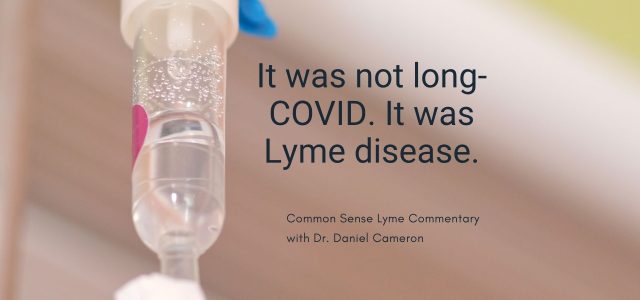
When It’s Not Long COVID—It’s Lyme
In the wake of the pandemic, we’ve become more aware of how a virus can lead to long-term, multisystem illness. That’s been a good thing. Patients with brain fog, fatigue, and shortness of breath are no longer automatically dismissed. They’re told it might be Long COVID—and for many, that’s exactly what it is.
But here’s the problem: not every post-viral–looking syndrome is post-viral. And not every case labeled Long COVID is the full story.
In my practice, I’ve seen patients whose symptoms—fatigue, headaches, lightheadedness, poor sleep, word-finding issues—were immediately attributed to Long COVID. Some of them had never tested positive. Others had recovered from COVID without issue… only to become chronically ill months or even years later.
In many of those cases, it wasn’t Long COVID.
It was Lyme disease. Or a co-infection like Babesia or Bartonella.
And no one had looked.
When Labels Limit Us
Long COVID has become a kind of medical shortcut. It’s a real condition—but it can also become a convenient label when the work of a thorough differential diagnosis gets skipped. When physicians assume that post-viral symptoms must be from COVID, they may never ask about:
- Tick exposure
- Unexplained rashes
- Travel or seasonal patterns
- Prior flu-like illnesses that were never diagnosed
- Co-infections that don’t respond to typical antivirals
I’ve seen patients treated for months as though they had Long COVID—when the missing piece was an untreated tick-borne illness.
Lyme Can Look Like Long COVID
The overlap is striking. Both Lyme and Long COVID can cause:
- Chronic fatigue
- Autonomic dysfunction (POTS)
- Cognitive impairment
- Exercise intolerance
- Sleep disruption
- Mood changes
- Migratory pain
- GI complaints
- Neurologic symptoms
So what’s the difference?
The treatment.
And the risk of missing it.
Because while there are still no definitive treatments for Long COVID, persistent Lyme and co-infections can be treated—if you know what you’re looking for.
The Cost of Delay
I’ve had patients who spent a year or more under the Long COVID umbrella before someone asked the right question: “Could this be Lyme?”
By then, their symptoms had worsened. Their trust had eroded. And their hope had faded.
When we finally ran the tests—sometimes imperfect, sometimes inconclusive but clinically suggestive—and began treatment for Lyme or Babesia, things began to change. Slowly. Unevenly. But unmistakably.
We Owe Patients More Than Assumptions
The Long COVID diagnosis has opened up important conversations. But we must be careful not to let it become the end of the diagnostic journey—especially when the story doesn’t quite fit.
If your patient has “Long COVID” but never tested positive, or their symptoms appeared well after a mild case, or they’re not improving despite supportive care—it’s worth asking:
- Was Lyme disease ruled out thoroughly?
- Were co-infections considered?
- Or were they just never brought up?
Sometimes the answer isn’t a new virus.
It’s an old infection.
Still waiting to be treated.



Lyme is the #1 misdiagnosed disease, 3x the rate of syphilis, the only other spiral-shaped bacteria that can corkscrew its way into all tissues. Lyme is much worse as it is a persister, has no good early tests, no outward signs and no good late treatment. Medical denialism is a tragedy that has harmed children and families for decades, millions of times worse than the Tuskegee Scandal when syphilis went untreated. The best way to help patients would be to REQUIRE NIH and all gov’t and ducational institutions whose mission is public health to budget at least half to the most costly, disabling and misdiagnosed diseases. Lyme would be on all 3 lists.
Dr. Cameron, thank you for all of this valuable and helpful information. And thank you for all of your research and dedication to lyme and other tick-borne diseases. You have helped so many people, and I for one, am grateful to you. God bless.
“Thank you. I truly believe God led me here for a reason—and it’s been a blessing to serve this community. May He continue to guide and heal us all.”
Thank you Dr Cameron. Going thru a flare up. 2nd one in a month. Last 24 hours and extreme aches , migraine, sweating, low grade fever and then gone just like that. Haven’t had lymes in 15 years but it feels like it. Also, I had meningitis a year after Lymes and it feels like that too. Good times 😉 Praise God for people like you helping people like me 🙏
Thank you 🙏 I’m sorry you’re going through this flare-up. I’ve seen patients experience this even years after initial infection. You’re not alone—and I’m grateful you’re still pushing forward. Praise God indeed.